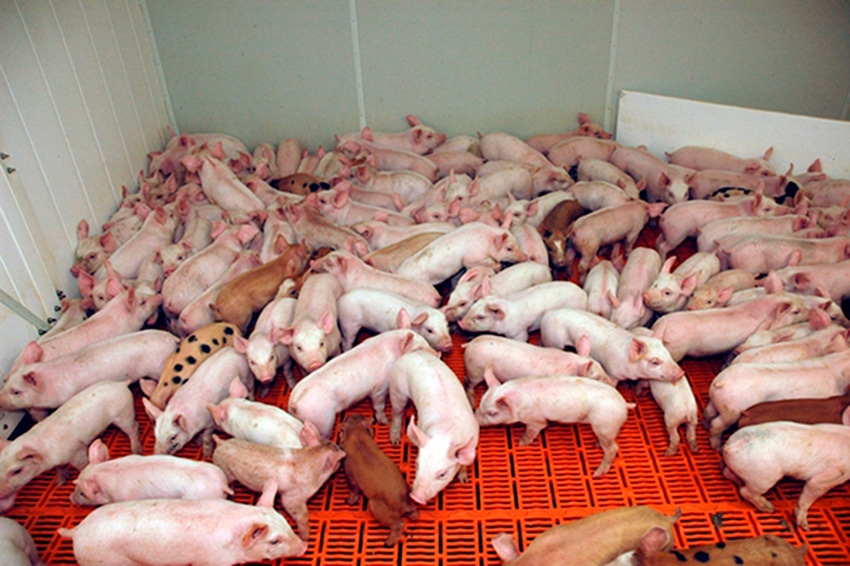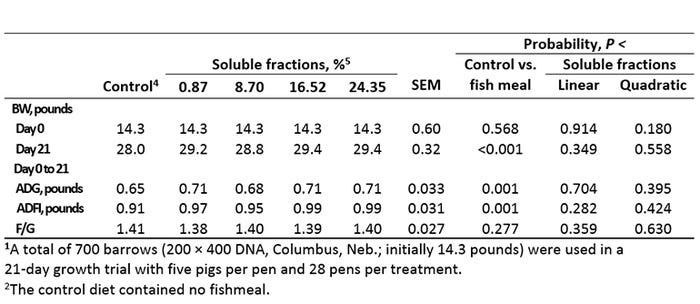Fish meal solubles — Do they influence nursery pig performance?
Both high and low solubles fish meal tested were of high quality, however, increasing fish solubles included in whole fish meal had no significant influence on growth performance.
February 22, 2018

By Aaron Jones, Jason Woodworth, Mike Tokach, Robert Goodband, Joel DeRouchey and Steve Dritz, Kansas State University; Scott Herbert, Jason Smith and Dalton Berry; Daybrook Fisheries Inc., New Orleans, La.
To encourage feed intake for newly weaned pigs, highly palatable and nutrient-dense protein sources, such as fish meal have historically been added to nursery diets. Fish meal is typically considered a very good protein source due to its balance of amino acids, vitamins and minerals, and presence of omega 3 fatty acids. However, the quality of fish meal used can vary considerably based on the species of fish, the freshness of the raw material and the processing of fish meal among others. Because of these factors, growth responses to fish meal have varied.
While the most likely explanation for these inconsistencies are a combination of the factors previously mentioned, it is unclear what role if any fish solubles may play. Fish solubles (sometimes known as stickwater concentrate) are a byproduct derived from the intermediate fraction (liquid phase) during the manufacturing process of fish meal. Fish meal commonly produced and sold today on average contains 8% to 15% fish solubles included in the final product. It is unclear if the amount of fish solubles contained within fish meal will influence growth performance of pigs. Therefore, the objective of our study was to evaluate the growth performance of nursery pigs fed fish meal with increasing amounts of fish solubles.
For this study, 700 barrows initially 21 days of age and 14.3 pounds body weight were used in a 21-day growth trial to one of five dietary treatments. Dietary treatments included a corn soybean meal-based control diet and four diets containing 6% LT Prime Menhaden Fishmeal (Daybrook Fisheries Inc., New Orleans, La.). One batch of fish meal contained 0.87% fish solubles and the second batch contained 24.35% solubles. The two batches were then blended to provide dietary treatments with 0.87%, 8.70%, 16.52% and 24.35% fish solubles. Dietary treatments contained 10% spray-dried whey and formulated to contain 1.35% standardized ileal digestible Lysine and balanced on a net energy basis.
When analyzing the two different fish meals for composition characteristics, low and high soluble fish meals were found to be high quality as indicated by the total volatile N concentration and modified Torry digestibility (Table 1). These tests are designed as indicators of the degrees of freshness of the raw fish used in the manufacturing process and protein quality of the finished product, respectively. A value less than 0.15% indicates that the fish meal is of good quality. The modified Torry digestibility is calculated as a portion of acid insoluble nitrogen that is soluble in acid pepsin solution, thus, correcting the amount of protein that is digestible by eliminating the water and fish soluble protein. Digestibility values were above 80% indicating the quality of protein was very good.

Table 1: Chemical analysis of fish meal, (as-fed basis)1,2
For growth performance, pigs fed diets containing fish meal had higher average daily gain and average daily feed intake (P < 0.001) compared with pigs fed the corn-soybean meal control diet but F/G was not affected. However, the amount of solubles in fish meal did not influence ADG, ADFI, F/G, or final BW.

Table 2: Effects of varying levels of fish solubles added back into fish meal on nursery pig performance1,2
In conclusion, this was the first study that we are aware of to determine the influence of increasing fish solubles contained within fish meal on growth performance of nursery pigs. Based on our findings, both the high and low solubles fish meal we tested were of high quality as indicated by the total volatile N analyses and modified Torry digestibility values. However, increasing fish solubles included in whole fish meal had no significant influence on growth performance. Thus, our results would suggest that the inconsistencies observed within the literature pertaining to growth responses when feeding fish meal to nursery pigs is not a reflection of the amount of fish solubles in whole fish meal.
You May Also Like



